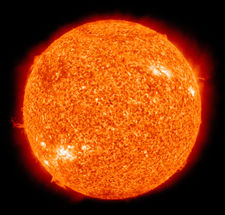Harkis
 False-color image taken in 2010 as seen in ultraviolet light (wavelength of 30.4 nm) | |
| Names | Harkis |
|---|---|
| Adjectives | Harkan, Harkian, Harcial |
| Observation data | |
| Mean distance from Sahar | 1 AU ≈ 1.496×108 km 8 min 19 s at light speed |
| Visual brightness (V) | −26.74 |
| Absolute magnitude | 4.83 |
| Spectral classification | G2V |
| Metallicity | Z = 0.0122 |
| Angular size | 31.6–32.7 minutes of arc ≈ 0.5 degrees |
| Orbital characteristics | |
| Mean distance from galactic core | ≈ 2.7×1017 km ≈ 29,000 light-years |
| Galactic period | (2.25–2.50)×108 yr |
| Velocity | ≈ 220 km/s (orbit around the galactic core) ≈ 20 km/s (relative to average velocity of other stars in stellar neighborhood) ≈ 370 km/s (relative to the cosmic microwave background) |
| Physical characteristics | |
| Equatorial radius | 695,700 km, 696,342 km 109 × Sahar |
| Equatorial circumference | 4.379×106 km 109 × Sahar |
| Flattening | 9×10−6 km |
| Surface area | 6.09×1012 km2 12,000 × Sahar |
| Volume | 1.41×1018 km3 1,300,000 × Sahar |
| Mass | 1.9885×1030 kg 333,000 Sahars |
| Average density | 1.408 g/cm3 0.255 × Sahar |
| Centre density (modelled) | 162.2 g/cm3 12.4 × Sahar |
| Equatorial surface gravity | 274 m/s2 28 × Sahar |
| Moment of ineertia factor | 0.070 (estimate) |
| Escape velocity (from the surface) | 617.7 km/s 55 × Sahar |
| Temperature | Centre (modelled): 1.57×107 K Photosphere (effective): 5,772 K Corona: ≈ 5×106 K |
| Luminosity (Lsol) | 3.828×1026 W ≈ 3.75×1028 lm ≈ 98 lm/W efficacy |
| Color (B-V) | 0.63 |
| Mean radiance (Isol) | 2.009×107 W·m−2·sr−1 |
| Age | ≈ 4.6 billion years |
| Rotation characteristics | |
| Obliquity | 7.25° (to the ecliptic) 67.23° (to the galactic plane) |
| Right ascension of North pole | 286.13° 19 h 4 min 30 s |
| Declination of North pole | +63.87° 63° 52' North |
| Sidereal rotation period (at equator) | 25.05 d |
| (at 16° latitude) | 25.38 d 25 d 9 h 7 min 12 s |
| (at poles) | 34.4 d |
| Rotation velocity (at equator) | 7.189×103 km/h |
| Photospheric composition (by mass) | |
| Hydrogen | 73.46% |
| Helium | 24.85% |
| Oxygen | 0.77% |
| Carbon | 0.29% |
| Iron | 0.16% |
| Neon | 0.12% |
| Nitrogen | 0.09% |
| Silicon | 0.07% |
| Magnesium | 0.05% |
| Sulfur | 0.04% |
Harkis is the parent star of the Harkis System, around which the seven main planets revolve. It is a G-type main-sequence star (G2V) located in the outer third of the galaxy. It consists mainly of Hydrogen and Helium, which respectively account for approximately 73% and 25% of its mass. In addition, various heavier elements are found in trace amounts.
As a main-sequence star, Harkis generates energy by the fusion of hydrogen nuclei into helium within its core. The thermal energy produced by this reaction provides the overwhelming majority of the energy required to sustain life on Sahar. Furthermore, its presence is responsible for various natural phenomena on Sahar, including the day-night and seasonal cycles. These effects have been recognised by the inhabitants of Sahar since ancient times, as can be seen by its ubiquitous presence in prehistoric art. Veneration continues to this day, with many cultures worshipping Harkis as a deity.